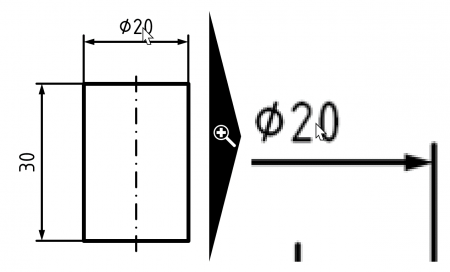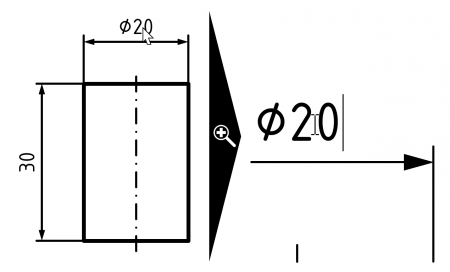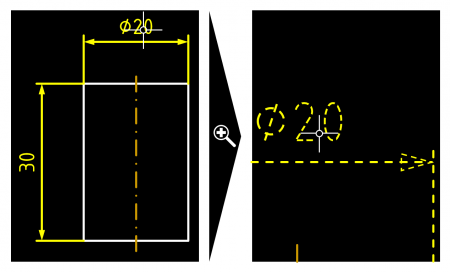infra CONVERT
blue DAT • infra DAT
mdm TOOL
infra CONVERT
blue DAT • infra DAT
mdm TOOL
This is an old revision of the document!
Various data formats have been established for the digital exchange of →technical drawings. Each data format transports at least the graphic information of a drawing printed on paper. In addition, vector formats and especially specially developed drawing data formats store information that facilitates automated readout by computer programs.
Basically, a technical drawing is constructed according to largely internationally defined standards from linear graphic elements as well as text elements. The reader derives the meaning from the arrangement of the elements in relation to each other. However, this kind of interpretation work can only be implemented by software to a very limited extent. For this reason, additional information is stored in drawing data formats, which indicates to a software that the elements belong together and what they mean.
The suitability of different data formats for automated interpretation can be generalized as follows:

In infra CONVERT, a CAD exchange format is the minimum requirement for fully automatic feature recognition.
Raster graphic formats only transport the graphic information addressed to the reader. Software can only retrieve the stored information (“pattern recognition”) by relating the pixels to one another. Actually used technologies concentrate on text recognition, the so-called “Optical Character Recognition” (OCR). They have a recognition rate of about 50 to 70 %, at least in the area of technical drawings.
In infra CONVERT, drawings in raster graphic format can be stamped manually using the quick input dialog.
See
Functions > Characteristics > Manually stamp

Vector graphic formats, on the other hand, store graphic elements as unique, mathematically described graphic primitives. The latter mean basic geometric elements such as straight lines, arcs, and splines, as well as surfaces such as circles, polygons, and spline surfaces. Texts are stored either as polylines or with the help of character encoding.
In infra CONVERT, character-coded texts are a prerequisite for automatic feature recognition.
The PDF format (PDF = “Portable Document Format”) supports raster-based and vector-based data storage. Coded text characters are stored in text fields, such as “⌀ 20” in the adjacent example.
In infra CONVERT, drawings in raster-based PDF format can be stamped manually using the quick input dialog. Drawings in vector-based PDF format can be stamped automatically* if the characters are coded.
* A pro license is required.
See
Functions > Characteristics > Manually stamp
Functions > Characteristics > Automatically stamp

Beim PDF-Format ist zu beachten, dass nicht alle CAD-Systeme alle Zeichen – meist Sonderzeichen – codiert exportieren, sondern als geometrische Elemente. Entsprechend verringert sich Eignung für die automatisierte Lesbarkeit.

CAD-Formate speichern Daten weitgehend Konstruktionselement-basiert. Ansichten, Schraffuren, Maßeintragungen etc. bleiben als solche für eine verarbeitende Software erkennbar, wie der Maßeintrag für der Durchmesser 20 des Zylinders im nebenstehenden Beispiel.
In infra CONVERT drawings can be processed in DXF format (“Drawing Interchange File Format”, worldwide and neutral industry standard), in DWG format (Autodesk's own format, also supported by most CAD systems) or in IGES format* (“Initial Graphics Exchange Specification”).
In infra CONVERT können Zeichnungen im DXF-Format (“Drawing Interchange File Format”, weltweiter und neutraler Industriestandard), im DWG-Format (Autodesk-eigenes Format, ebenfalls von den meisten CAD-Systemen unterstützt) oder auch im IGES-Format* (“Initial Graphics Exchange Specification”) verarbeitet werden.
* Es ist eine Lizenz für das IGES-Modul erforderlich.
Anmerkung Die “bunte” Darstellung von nativen CAD-Zeichnungsformaten hat den Hintergrund, dass die Farben Strichstärken codieren. In den Anfangszeiten des CAD konnten unterschiedliche Linienbreiten nur schlecht mit der damaligen Technik am Bildschirm dargestellt werden. Einer Farbe war auf dem Plotter ein Tuschestift zugeordnet. Eine Zuordnungstabelle für Linienbreiten (“Pentable”) wird in die gängigen Austauschformate meist nicht exportiert. Zur besseren Lesbarkeit stellt infra CONVERT Zeichnungen daher standardmäßig monochrom dar (“Schwarz auf Weiß”).
